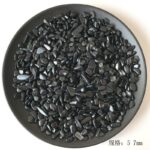Introduction
Emerald, the captivating green gemstone, has held the fascination of humankind for centuries. Known for its enticing hue and legendary healing powers, emerald continues to captivate hearts and minds. This article delves into the enigmatic world of the esmeralda stone, exploring its unique properties, historical significance, and multifaceted applications.

Mystical Properties
Emerald’s allure extends beyond its aesthetic appeal. Ancient civilizations believed in its potent healing abilities, using it to treat ailments ranging from vision problems to skin conditions. Emerald is also said to promote emotional well-being, fostering harmony, clarity, and tranquility.
Historical Significance
Emerald has a rich history, dating back to ancient Egypt. Cleopatra, the iconic queen, was known for her love of emeralds, adorning herself with exquisite jewelry. In the Roman Empire, emerald was prized for its association with the goddess Venus, who represented love and beauty.
Origins and Formation
Emerald is a variety of the mineral beryl, its distinct green color attributed to trace amounts of chromium or vanadium. It typically forms in metamorphic rocks under high pressure and temperature. Colombia is renowned for producing some of the finest emeralds in the world, accounting for approximately 70-90% of the global supply.
Applications
Emerald’s versatility extends beyond its traditional use in jewelry. It has found applications in various fields, including:
-
Jewelry:
Emerald’s captivating beauty makes it a sought-after gemstone for jewelry enthusiasts. It is commonly set in pendants, rings, earrings, and bracelets. -
Health:
Emerald’s alleged healing properties have led to its use in alternative medicine. Some practitioners believe it can aid in detoxification, improve vision, and balance emotional states. -
Gemology:
Emerald is a key mineral in the field of gemology, serving as a reference point for studying beryl’s properties. Its distinct characteristics help identify and classify different types of beryl.
Investment and Value
Emerald’s rarity and desirability make it a valuable investment. The gemstone market is heavily influenced by factors such as carat weight, clarity, color, and cut. High-quality emeralds command a premium price, with larger and more flawless specimens fetching top dollar.
Color and Clarity
Emerald’s green color is its defining characteristic. The most desirable shade is known as “verde esmeralda,” a deep, vibrant green hue. Clarity is another important factor, as inclusions and blemishes can affect the stone’s value. Internally flawless emeralds are exceedingly rare and highly sought after.
Carat Weight and Cut
Carat weight refers to the size of an emerald, with one carat equaling 200 milligrams. Larger emeralds are rarer and more valuable. The cut of an emerald affects its brilliance and sparkle. Popular emerald cuts include round, emerald-cut, oval, and pear-shaped.
Market Trends
The global emerald market has witnessed steady growth in recent years, driven by rising demand for high-end jewelry and increasing investment in gemstones. According to the World Bank, the global gemstone market is projected to reach $45 billion by 2025. Emeralds are expected to continue to be a key driver of this growth.
Challenges and Pain Points
The emerald industry faces several challenges, including:
-
Environmental Concerns:
Emerald mining can have negative environmental impacts, such as deforestation and water pollution. Sustainable and responsible mining practices are crucial for mitigating these concerns. -
Ethical Issues:
Emerald mining in some regions has been linked to human rights violations and labor exploitation. Ensuring ethical supply chains is essential for the long-term sustainability of the industry. -
Synthetic Emeralds:
The advent of synthetic emeralds, which are created in laboratories, poses a challenge to the natural emerald market. Distinguishing between natural and synthetic emeralds requires specialized knowledge and equipment.
Tips and Tricks for Selecting Emerald
When selecting an emerald, consider the following tips:
-
Consider the Color:
Look for emeralds with a deep, vibrant green hue. Avoid stones with yellow or brown undertones. -
Check the Clarity:
Emeralds with fewer inclusions and blemishes are more valuable. Use a magnifying glass to inspect the stone for imperfections. -
Examine the Carat Weight:
Larger emeralds are rarer and more valuable. However, consider the size that suits your needs and budget. -
Assess the Cut:
The cut of an emerald affects its brilliance and sparkle. Choose a cut that complements the shape and size of the stone.
Frequently Asked Questions (FAQs)
-
Are emeralds rare?
Yes, emeralds are relatively rare compared to other gemstones. Fine-quality emeralds are especially scarce. -
What is the difference between emerald and peridot?
Emerald and peridot are both green gemstones, but emerald is a variety of beryl, while peridot is a form of olivine. Emerald typically has a deeper, more vibrant green color than peridot. -
Can emeralds be cleaned with ultrasonic cleaners?
Ultrasonic cleaners can damage emeralds, as they can cause the stones to fracture. It is recommended to clean emeralds using a soft brush and lukewarm soapy water. -
What is the Mohs scale hardness of emerald?
Emerald has a Mohs scale hardness of 7.5-8, making it relatively hard and durable. However, it can still be scratched by harder materials such as diamonds. -
How can I avoid buying synthetic emeralds?
Purchase emeralds from reputable dealers who provide certificates of authenticity. Laboratory-created emeralds can be identified using specialized equipment by trained gemologists. -
What is the average price of an emerald?
The price of an emerald varies widely depending on its quality and size. High-quality emeralds can range from $1,000 to over $100,000 per carat.
Glossary of Terms
- Beryl: A mineral that can form different varieties of gemstones, including emerald and aquamarine.
- Carat: A unit of weight used to measure gemstones, equal to 200 milligrams.
- Clarity: A gemstone’s transparency and freedom from inclusions and blemishes.
- Color: The hue and saturation of a gemstone, which influences its value.
- Cut: The shape and facets of a gemstone, which affects its brilliance and sparkle.
- Mohs scale: A measure of a mineral’s hardness, with diamond being the hardest at 10.
- Synthetic emerald: A laboratory-created gemstone that resembles natural emerald in appearance.
Table 1: Emerald Production by Country
| Country | Production (Carats) |
|---|---|
| Colombia | 1.8 million |
| Zambia | 800,000 |
| Brazil | 700,000 |
| Afghanistan | 500,000 |
| Madagascar | 400,000 |
Table 2: Emerald Value Factors
| Factor | Influence on Value |
|---|---|
| Color | Deep, vibrant green hue is most desirable. |
| Clarity | Fewer inclusions and blemishes increase value. |
| Carat Weight | Larger emeralds are rarer and more valuable. |
| Cut | Brilliant cuts maximize sparkle and enhance beauty. |
Table 3: Emerald Care and Maintenance
| Task | Recommended Method |
|---|---|
| Cleaning | Use a soft brush and lukewarm soapy water. Avoid ultrasonic cleaners. |
| Storage | Store emeralds in a cool, dry place away from other gemstones. |
| Inspection | Have emeralds inspected by a jeweler annually to check for damage or wear. |
Table 4: Emerald Applications
| Application | Benefits |
|---|---|
| Jewelry: | Stunning appearance and emotional significance |
| Health: | Alleged healing properties for various ailments |
| Gemology: | Reference point for studying beryl’s properties |
| Investment: | Rare and valuable gemstone with potential for appreciation |
Conclusion
The esmeralda stone, with its captivating beauty, legendary healing powers, and diverse applications, continues to fascinate and inspire. Whether adorning jewelry or serving as a source of healing and introspection, emerald’s allure transcends time and cultures. As the industry evolves, with advancements in mining techniques and a growing focus on sustainability, the future of esmeralda stone remains bright, promising new discoveries and applications that will captivate generations to come.




























